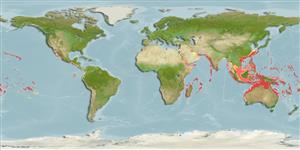Common names from other countries
Environment: milieu / climate zone / depth range / distribution range
Ecologia
marinhas associadas(os) a recifes; oceanódromo (Ref. 51243); intervalo de profundidade 8 - 186 m (Ref. 9710), usually 18 - ? m (Ref. 9710). Tropical; 30°N - 32°S
Indo-Pacific: Red Sea, East Africa through northern Australia to the Hawaiian, Marquesas and Pitcain Islands; north to southern Japan.
Tamanho / Peso / Idade
Maturity: Lm ? range ? - ? cm
Max length : 38.0 cm TL macho/indeterminado; (Ref. 9710); common length : 26.0 cm TL macho/indeterminado; (Ref. 5450)
Espinhos dorsais (total) : 3; Raios dorsais (total) : 27 - 31; Espinhos anais: 0; Raios anais : 24 - 28. Juveniles sand-colored with numerous thin black pinstripes (Ref. 1602); adult males with an oblique yellow band from the corner of mouth backward and another under the chin (Ref. 4420).
Inhabit coastal rocky reefs, often silty habitats and in lagoons on open sand (Ref. 48637). Solitary (Ref. 90102). Found over sand and rubble patches of seaward reefs (Ref. 205). Benthopelagic (Ref. 58302). Feed on echinoids, fishes, mollusks, tunicates, crustaceans, algae, polychaete worms, foraminiferans and detritus. Oviparous (Ref. 205).
Ciclo de vida ou comportamento de acasalamento
Maturities | Reprodução | Spawnings | Egg(s) | Fecundities | Larvas
Distinct pairing (Ref. 205). Females are territorial, solely tending and guarding the eggs (Ref. 116451). Males exhibit polygyny (Ref. 116451).
Myers, R.F., 1991. Micronesian reef fishes. Second Ed. Coral Graphics, Barrigada, Guam. 298 p. (Ref. 1602)
Status na Lista Vermelha da UICN (Ref. 130435)
CITES (Ref. 128078)
Not Evaluated
Ameaça para os humanos
Harmless
Uso pelos humanos
Pescarias: pouco comercial; Aquário: Espécies comerciais
Ferramentas
Relatórios especiais
Baixar XML
Fontes da internet
Estimates based on models
Preferred temperature (Ref.
115969): 23.4 - 28.9, mean 27.5 (based on 2060 cells).
Índice de diversidade filogenética (Ref.
82804): PD
50 = 0.5312 [Uniqueness, from 0.5 = low to 2.0 = high].
Bayesian length-weight: a=0.02512 (0.01557 - 0.04053), b=2.94 (2.80 - 3.08), in cm Total Length, based on LWR estimates for this species & (Sub)family-body (Ref.
93245).
Nível Trófico (Ref.
69278): 3.7 ±0.2 se; based on diet studies.
Resiliência (Ref.
120179): médio(a), tempo mínimo de duplicação da população 1,4 - 4,4 anos (Preliminary K or Fecundity.).
Fishing Vulnerability (Ref.
59153): Low to moderate vulnerability (28 of 100).
